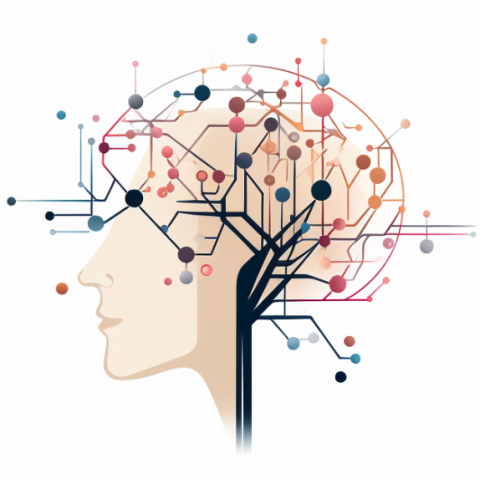
Dynamic AI
Co-Creation
A Human-Centered Approach
Paragraph description....

Dynamic AI Co-Creation: A Human-Centered Approach is an Open Educational Resource (OER), funded by Washington State University. It is designed for anyone looking to explore the transformative potential of generative AI in creative practice. Whether you are a student, educator, professional, or part of project team, this guide will provide you with the foundational knowledge and tools to integrate AI into your own creative, research, and project development workflows.
Dynamic AI Co-Creation emphasizes the complex partnership between human ingenuity and machine intelligence. AI offers unprecedented opportunities to enhance creative intuition, streamline production, and innovate across various domains. While AI tools speed up iteration processes, this should be considered as an opportunity to slow down in human processes. The true power of AI lies in its ability to augment human potential, enabling us to explore deeper, invent more intuitively and collaborate more effectively.
By fostering a mindset of agility and co-creation, you will be better equipped to navigate the evolving landscape of generative AI and harness its full potential.
This OER document, its design and coding as a website along with the writing were developed using AI tooks like ChatGPT and Midjourney. Most of the content and structure were developed from a Spring 2024 class I taught called "AI in the Arts."




Narratives depicting AI as an existential threat to humanity have long permeated popular culture and fiction. From Dr. Frankenstein's creation to HAL 9000 in 2001: A Space Odyssey and the humanoid replicants of Blade Runner, our fears of intelligent machines surpassing our control are personified in iconic cautionary tales. These stories expose deep-seated anxieties around surrendering our agency and being subjugated by our own technological creations.
While fictionalized, the "robot monster" narratives are rooted in real concerns underlying AI development. As systems grow more autonomous and general in their capabilities, we must grapple with challenges like value alignment (ensuring AI behaves in accordance with human ethics/goals), transparency and accountability, inherited cultural biases, and AI safety (preventing situations where superintelligent systems pursue counterproductive or destructive ends).
"robot" helpers...r2d2, c3po.Isaac Asimov's Three Laws of Robotics, in his I, Robot, that are designed to ensure machines remain subservient tools for human good, often result in unintended dystopian consequences when rigorously applied within these fictional frameworks. This underscores the nuanced complexity of appropriately codifying moral training data into foundations for machine ethics and behavior.
Rules and strictures will no doubt be formalized in top down laws for the use of AI in products and services. But cultural practices, with any new technology, usually come from the bottom up. They come out of daily needs and desires, embodied experience and socio-economic conditions. Cultural practices working with the boundaries of what is legal get worked out over time and therefore require some patience and discernment. Electricity was a powerful and lifethreatening technology in its inception, but with proper laws and restrictions electricity became a useful and express tool in cuture. To prevent AI from becoming another one of our feared "robot monsters", leave behind what is not useful to your well-being and embrace what is. That is a human-centered approach to an inhuman but powerful tool.
The current era of rapid AI growth has its roots in pivotal 20th century developments that transitioned the field from narrow rule-based systems to the flexibly programmable machines leveraging vast datasets that we interact with today.
AI EXPLAIN SYMBOLIC SYSTEMS..... The Turing Test proposed by Alan Turing in 1950 established a framework for evaluating a system's capability to exhibit intelligent behavior indistinguishable from a human. This ushered in the earliest symbolic AI approaches attempting to reduce intelligence into abstract logical operations. However, the field languished for decades as researchers struggled to make brittle systems generalize beyond their narrow training domains.
Eliza...
The breakthrough was the emergence of machine learning techniques like neural networks and deep learning models in the 1990s and 2000s. By empowering software to ingest and learn patterns from large datasets, these probabilistic methods finally allowed AI to effectively acquire knowledge in more organic, scalable ways - rather than through manually coded rules.
Milestones like IBM's Deep Blue defeating world chess champion Garry Kasparov in 1997 and recent achievements in realms like computer vision, speech recognition, and autonomous vehicles highlighted AI's rapidly generalizing capability across complex problem spaces once thought exclusive to human aptitude.
...
Even as AI automates routine tasks and augments human performance in technical fields, its impacts are being felt across the humanities and creative arts as well. Generative language models can assist in crafting poetry, fiction, scripts, images, music, videos, websites and apps - opening doors to new forms of human-AI hybrid storytelling and expression. AI image generators provide powerful visualization tools for artists, filmmakers, and designers. Music composition and other creative pursuits are being reshaped by AI's ability to generate novel outputs.
Beyond just productivity tools, AI is catalyzing an aesthetic renaissance exploring philosophical questions about the essence of being, the nature of intelligence, and the interplay between logic and emotion. The lines between human and machine, creativity and computation, are blurring - conjuring Ada Lovelace's visionary 19th century perspective that coding and analytical engines could one day interweave with arts and spirituality through a "poetical science."
By integrating AI into humanities curricula and embracing it as a canvas for creative and critical expression, we gain powerful new outlets for exploring the human condition through technological lenses. Students can experiment with prompting AI to generate philosophical debate about machine sentience, or produce multimedia pieces commenting on the implications of intelligent machines in culture. Courses spanning art, literature, ethics, and cultural studies can engage AI as an object of scrutiny and reinterpretation.
Ultimately, leaning into this intersection allows the humanities to maintain relevance in a world of accelerating technological change. Just as previous eras wrestled with industrialization's impacts through new artistic movements, today's scholars and creatives can shape narratives around AI's role in society. The humanities can provide the critical perspective to ensure machines remain aligned with human flourishing.
...
One of the most powerful and controversial implications of AI's growth is its potential to fundamentally reshape how we approach creativity, learning, and education. While industrial robotics displaced human labor, AI automation now encroaches on cognitive territories like knowledge work, teaching, and artistic expression once thought impervious.
From AI tutors that can deliver personalized lesson plans based on student needs, to generative tools that empower learners to conjure poems, essays, or code from text prompts, to AI analysis that unearths insights across vast datasets - intelligent software is transforming our relationship with intelligence itself. Yet this coexists with fears that AI could make human skills obsolete and undermine education by enabling dishonest shortcuts.
The debate around AI's capacity for true creativity surfaces age-old inquiries over what separates sentient beings from sophisticated calculation machines. Can AI systems merely repackage derivative remixes of training data, or might they evolve the ability for original creative expression akin to the human mind?
Despite the controversy, tools like DALL-E, GPT-3, and language models are already empowering students and lifelong learners to enhance their creative output while potentially accelerating proficiency in technical skills. For educators, the challenge is how to leverage AI as a complementary aid that expands possibilities rather than eroding the fundamentals of critical thinking, integrity, and human-led pedagogy.
In this exercise, you will begin a creative research project using ChatGPT, preferably the Plus version which allows you to design your own GPT. The free version will also work. The goal is to explore how AI can catalyze your creative process while examining its current boundaries and future potentials. This exercise combines practical AI literacy with high-level inquiries into AI's role in shaping how we create, learn, and collaboratively explore the world around us.
Introduction: I'm a 25-year-old male passionate about creative writing, particularly short stories and graphic novels. I have an interest in video production. My love for fiction, graphic novels, and all genres of movies fuels my creativity. I'm excited to explore the potential of AI tools in creating graphic novels. I sometimes struggle with procrastination, but it helps to have projects broken into smaller tasks.
Objective: My goal is to develop a GPT model that acts as my creative partner, assisting me in generating ideas, developing storylines, and providing guidance in AI image generation. I want the GPT to understand my unique writing style with samples of my stories. This model will also help me stay focused and motivated by breaking projects into smaller tasks.
Introduction: I am a 20-year-old biology major with a passion for painting, music, hiking, and outdoor activities. As a summer forest camp teacher for children aged 8-14, I seek to integrate creative AI into my teaching methods. This GPT model should assist me in generating innovative ideas and techniques for teaching about the forest and the environment, leveraging AI's creative potential.
Objective: To develop a GPT model tailored to assist in creating engaging, informative, and creative educational content and activities for young learners in a forest camp setting. The model will focus on combining elements of biology, art, music, and outdoor education with AI-driven creativity.
Discussions are aimed at unpacking the dichotomy of AI fears and utopian myths, from job displacement and loss of human creativity to envisioning a future where AI aids in addressing global challenges, fostering a balanced perspective on technological advancement.
The contributions of pioneers in the field, such as Alan Turing, John McCarthy, and contemporary artists like Refik Anadol and Taryn Southern, are acknowledged, highlighting the breadth of AI's application and its profound implications for the future of art and science.